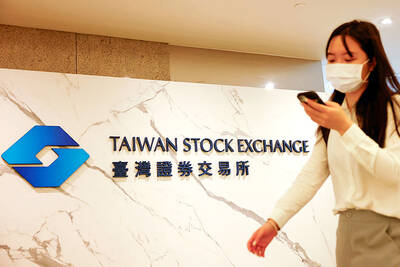The nation’s industrial production index climbed by 3.07 percent last month from the same period last year, driven by rising output of semiconductors, steel and petrochemical goods, the Ministry of Economic Affairs said yesterday.
The result marked the third consecutive month of annual expansion in industrial production, the ministry’s data showed.
That brought the industrial production index swinging back into positive territory for the first 10 months of this year to an increase of 0.21 percent from the same period last year.
“We are optimistic that overall industrial production this year can grow from last year,” Department of Statistics Deputy Director-General Wang Shu-chuan (王淑娟) told a news conference.
The industrial production gauge measures output in five major industries: manufacturing; mining and quarrying; electricity and gas supply; water supply; and architectural engineering.
The manufacturing sector — which accounts for more than 90 percent of industrial output — rose 5.67 percent last month from the same period last year, the data showed.
The electronics components industry, which is a pillar of the manufacturing sector, rose 14.09 percent from a year ago, supported by production of semiconductors and flat panels, Wang said.
The base metal industry jumped 16.39 percent annually in production last month, mainly fueled by billets and hot and cold-rolled steels, she said.
The PC and optical components industry was the dark spot last month, plunging 8.72 percent from a year ago, due to falling production of smartphones and camera lenses used in handsets, Wang said.
The ministry forecast that industrial output could grow by as much as 5 percent year-on-year this month, on the back of a strong market response to consumer electronics due to holiday demand in the West, Wang said.
The recovering prices of global crude oil and base metals would help to boost production of petrochemical and steel products this month, she added.
Separately, the ministry said that the wholesale sector’s revenue grew 0.4 percent annually to NT$827.4 billion (US$25.95 billion) last month on rising demand for communications chips, flat panels and DRAM used in smartphones and servers.
The retail sector’s revenue expanded 0.4 percent year-on-year to NT$356.7 billion last month, while the food and beverage sector surged 6.8 percent annually to NT$37.2 billion, data showed.
The ministry forecast that Christmas and New Year holiday demand would help the wholesale sector’s revenue climb 0.1 percent this month from the same period last year, Wang said.
Singles’ Day shopping promotions and department stores’ anniversary sales are expected to help the retail sector’s revenue grow between 0.1 percent and 0.2 percent annually this month, she said, adding that department stores’ promotions are forecast to help the food and beverage sector’s revenue increase 5 percent this month.
In the first 10 months of this year, sales posted by the retail and food and beverage industries rose 1.8 percent and 3.2 percent, respectively, to NT$3.37 trillion and NT$366.1 billion, while revenue generated by the wholesale sector fell 3.1 percent year-on-year to NT$7.84 trillion, data showed.

ADVANCED: Previously, Taiwanese chip companies were restricted from building overseas fabs with technology less than two generations behind domestic factories Taiwan Semiconductor Manufacturing Co (TSMC, 台積電), a major chip supplier to Nvidia Corp, would no longer be restricted from investing in next-generation 2-nanometer chip production in the US, the Ministry of Economic Affairs said yesterday. However, the ministry added that the world’s biggest contract chipmaker would not be making any reckless decisions, given the weight of its up to US$30 billion investment. To safeguard Taiwan’s chip technology advantages, the government has barred local chipmakers from making chips using more advanced technologies at their overseas factories, in China particularly. Chipmakers were previously only allowed to produce chips using less advanced technologies, specifically

BRAVE NEW WORLD: Nvidia believes that AI would fuel a new industrial revolution and would ‘do whatever we can’ to guide US AI policy, CEO Jensen Huang said Nvidia Corp cofounder and chief executive officer Jensen Huang (黃仁勳) on Tuesday said he is ready to meet US president-elect Donald Trump and offer his help to the incoming administration. “I’d be delighted to go see him and congratulate him, and do whatever we can to make this administration succeed,” Huang said in an interview with Bloomberg Television, adding that he has not been invited to visit Trump’s home base at Mar-a-Lago in Florida yet. As head of the world’s most valuable chipmaker, Huang has an opportunity to help steer the administration’s artificial intelligence (AI) policy at a moment of rapid change.

The New Taiwan dollar is on the verge of overtaking the yuan as Asia’s best carry-trade target given its lower risk of interest-rate and currency volatility. A strategy of borrowing the New Taiwan dollar to invest in higher-yielding alternatives has generated the second-highest return over the past month among Asian currencies behind the yuan, based on the Sharpe ratio that measures risk-adjusted relative returns. The New Taiwan dollar may soon replace its Chinese peer as the region’s favored carry trade tool, analysts say, citing Beijing’s efforts to support the yuan that can create wild swings in borrowing costs. In contrast,

TARIFF SURGE: The strong performance could be attributed to the growing artificial intelligence device market and mass orders ahead of potential US tariffs, analysts said The combined revenue of companies listed on the Taiwan Stock Exchange and the Taipei Exchange for the whole of last year totaled NT$44.66 trillion (US$1.35 trillion), up 12.8 percent year-on-year and hit a record high, data compiled by investment consulting firm CMoney showed on Saturday. The result came after listed firms reported a 23.92 percent annual increase in combined revenue for last month at NT$4.1 trillion, the second-highest for the month of December on record, and posted a 15.63 percent rise in combined revenue for the December quarter at NT$12.25 billion, the highest quarterly figure ever, the data showed. Analysts attributed the